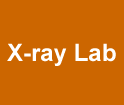

 |
 |
 |
 |
 |
 |
 |
 |
 |
High-Resolution (HR) mode is mainly suited for single crystals, nearly perfect epitaxial layers as well as textured epitaxial layers. This mode can be used for w/2q scan, rocking curve (w scan), and reciprocal space mapping.
In X-ray Lab HR measurements can be done on PANalytical X'Pert 1 diffractometer using the following optics:
Incident Beam:
PreFix Hybrid Monochromator
Diffracted Beam:
Triple Axis/Rocking Curve (TA/RC) attachment
RC part consists of receiving slit
Triple Axis part carries an analyzer crystal
Incident beam monochromator significantly reduces x-ray beam divergence (up to 5 arc sec for Bartels Monochromator with Ge(440) reflection). It also eliminates Ka2 line leaving only Ka1 component. High resolution monochromator is a four-crystal monochromator. The crystals have (110) surfaces and are preset for Ge(220) or Ge(440) Cu Ka1 reflections.
Hybrid monochromator consists of a parabolic graded multilayer mirror (x-ray mirror) and a channel-cut Ge crystal combined in one module. By passing a slightly broader spectral range (~19 arc sec) than 4-crystal HR monochromator, the hybrid monochromator delivers much more intense parallel beam of Ka1 radiation. The Ka2 component is suppressed to a level below 0.1%.
Remarks:
Hybrid monochromators are less applicable for RC measurements at 2q> 90 deg. The hybrid spectral band-pass of a hybrid monochromator is broader than that of 4-crystal HR monochromator. At high 2q angles the wavelength dispersion causes broad diffraction peaks, leading to a decrease in diffractometer resolution.
A small fraction of Ka2 radiation (0.05 - 0.1 %) is present in the XRD spectrum emitting from a hybrid monochromator. It may become visible during reciprocal space mapping with large dynamic range.
High Resolution applications and the required equipment
| Application | Incident Beam Optics | Diffracted Beam Optics | Remarks | Notes |
| Rocking Curve (w-scan) | Hybrid Monochromator | TA/RC Attachment (Receiving Slit Part) | Line focus, highest intensity. | w-scan provides resolution defined by the incident beam monochromator. 2q-scan provides resolution defined by the receiving slit. |
| 4-crystal Monochromator, Ge(220) | Point focus, higher resolution, lower intensity. | |||
| 4-crystal Monochromator, Ge(440) | Point focus, highest resolution, low intensity. | |||
| Reciprocal Space Maps | Hybrid Monochromator | TA/RC Attachment (Triple Axis Part) | Line focus, highest intensity. | w-scan resolution defined by the incident beam monochromator. 2q-scan resolution defined by analyzer crystal (~12 arc sec). |
| 4-crystal Monochromator, Ge(220) | Point focus, higher resolution, lower intensity. | |||
| w-2q scan, phase analysis | Hybrid Monochromator | TA/RC Attachment (Receiving Slit Part) | Line focus, highest intensity. | Only Ka1 component is present. |
| 4-crystal Monochromator, Ge(220) | Point focus, lower intensity. | |||
| w-stress analysis | Hybrid Monochromator | Parallel Plate Collimator | Ka1 only. | The hybrid monochromator allows to determine peak positions accurately since Ka2 stripping is not necessary and the background intensity is very low. |
| Reflectivity | Hybrid Monochromator | Parallel Plate Collimator | Use collimator slit. Ka1 only. | The monochromatic parallel incident beam reduces the background intensity and improves the resolution. |
| TA/RC Attachment (Triple Axis Part) | Highest resolution. Lower intensity. | 19 arc sec resolution in w and ~12 arc sec resolution in 2q make beam very narrow and parallel. |